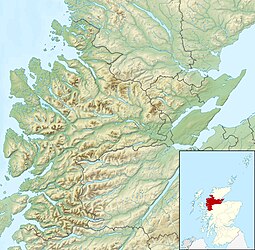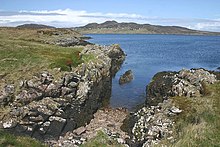| Scottish Gaelic name | Tannara Mòr |
|---|---|
| Meaning of name | "Harbour island", from Norse |
| Location | |
 | |
| OS grid reference | NB992067 |
| Coordinates | 58°01′N 5°25′W / 58.01°N 5.42°W / 58.01; -5.42 |
| Physical geography | |
| Island group | Summer Isles |
| Area | 310 ha (1+1⁄4 sq mi) |
| Area rank | 86 |
| Highest elevation | Meall Mòr, 124 m (407 ft) |
| Administration | |
| Council area | Highland |
| Country | Scotland |
| Sovereign state | United Kingdom |
| Demographics | |
| Population | 4 (2011) 0 (2014) |
| Population rank | 77= (2011) |
| Population density | 3.2/km (8.3/sq mi) |
| References | |
Tanera Mòr (Scottish Gaelic: Tannara Mòr) is a sporadically inhabited island in Loch Broom in the Inner Hebrides of Scotland, the largest of the Summer Isles. It was the last permanently inhabited island in that group. Tanera Mòr has issued its own postage stamps and was the location of Frank Fraser Darling's book Island Years. In 2014, it was reported that it had been sold to the millionaire Ian Wace, whose plans were to develop it as a holiday destination.
Geography

Tanera Mòr is around 310 hectares (766 acres) and reaches a height of 124 metres (407 feet). The highest hill is Meall Mòr (a common Scottish mountain name, meaning a "big rounded hill").
The rock is Torridonian sandstone covered with peat and pasture.

History
The island was a port for herring fishing, and suffered the decline of that industry. The two settlements were known as Ardnagoine and Garadheancal.
In 1881, there were no fewer than 118 people living on Tanera Mòr, all of whom had left by 1931 (one year after St Kilda was abandoned). Permanent habitation has been intermittent since then, with six people identified as resident in 1961, eight in 1981, none in 1991 and then five at the 2001 census and four in 2011. The last residents, owners Lizzie and Richard Williams, were reported to have left the island in 2014.
The island was bought in the early 1960s by Ken Frampton. In September 2012, it was revealed that the island's owners Lizzie and Richard Williams were considering a community buyout with residents on the mainland nearby. The price to the Coigach development trust has been assessed at £2.6 million. This proposal did not progress, however, and the island was placed on the open market in May 2013 for £2.5 million. By 2014 the price had been dropped to £1.95 million by owners Richard and Lizzie Williams, who had moved to the mainland.
In June 2017, Ian Wace purchased the island for £1.7 million, far less than the £2.5 million asking price when it was put on the market in 2013. It was reported that he would oversee a four-year development of Tanera Mòr, which could become an "idyllic retreat capable of hosting up to 60 paying guests".
Facilities and infrastructure
Tanera Mòr is home to a salmon fish farm, several holiday cottages, a small sailing school, a café and a post office, which has operated its own local post and printed its own stamps since 1970. The island previously had no roads and the only recognisable path went around An Acarsaid ("The Anchorage"), the sheltered bay on the east side of the island. Since 2017, the redevelopment of the island has involved the creation of several roads. Tanera Mòr, like the other Summer Isles, can be seen from the Stornoway to Ullapool ferry. The island can be reached by boat from either Achiltibuie in Wester Ross, or Ullapool.
Literary references
Tanera Mòr was the location for Frank Fraser Darling's book Island Years (published 1940), which describes experiences living on a remote island. Living in Tanera Mòr and Dundonnell before that, Fraser Darling began the work that was to mark him as a naturalist-philosopher of original turn of mind and great intellectual drive. He described the social and breeding behaviour of the red deer, gulls, and the grey seal respectively, in the three academic works A Herd of Red Deer, Bird Flocks and the Breeding Cycle and A Naturalist on Rona. The outbreak of World War II put an end to Fraser Darling's hopes of undertaking further research on the grey seal, and being too old for active military service, he chose to farm rather than leave the west coast of Scotland for wartime civilian work. Between 1939 and 1943 Fraser Darling reclaimed derelict land to agricultural production on Tanera Mòr in the Summer Isles, an undertaking described in his 1943 book Island Farm. In 1942 the wartime Secretary of State for Scotland, Tom Johnston, asked Fraser Darling if he would run an agricultural advisory programme in the crofting areas of the Scottish Highlands and Islands. He agreed, and for two years he travelled, taught and wrote articles that were later published in book form as Crofting Agriculture.
The pagan-cult island of Summerisle featured in the motion picture The Wicker Man (filmed 1973) is thought by some film critics to be set in this archipelago, although the movie itself was filmed in Galloway and Skye.
The Summer Isles feature in a novella of the same name by Ian R. MacLeod. Tanera Mòr also serves as the setting for the novella Ailie's Island by Antal Khripko (2023).
Wildlife
The island's floral diversity is strong due to the lack of grazing over the last 25 years, with northern marsh orchids and greater butterfly-orchids particularly strong. Eurasian otters are active, whilst common and grey seals frequently visit from the other nearby Summer Isles, and basking sharks and porpoises pass by in summer. Bird species include common eider, grey heron, red grouse, and common buzzards.
See also
58°0′40″N 5°24′30″W / 58.01111°N 5.40833°W / 58.01111; -5.40833
References
- ^ Area and population ranks: there are c. 300 islands over 20 ha in extent and 93 permanently inhabited islands were listed in the 2011 census.
- ^ National Records of Scotland (15 August 2013). "Appendix 2: Population and households on Scotland's Inhabited Islands" (PDF). Statistical Bulletin: 2011 Census: First Results on Population and Household Estimates for Scotland Release 1C (Part Two) (PDF) (Report). SG/2013/126. Retrieved 14 August 2020.
- ^ Kane, Jenny (20 November 2014) "Last permanent residents leave Summer Isles for the mainland". The Herald. Glasgow.
- ^ Haswell-Smith (2004) The Scottish Islands. Edinburgh. Canongate. Pages 195-7.
- Ordnance Survey. OS Maps Online (Map). 1:25,000. Leisure.
- Iain Mac an Tailleir. "Placenames" (PDF). Pàrlamaid na h-Alba. Archived from the original (PDF) on 29 May 2008. Retrieved 23 July 2007.
- General Register Office for Scotland (28 November 2003) Scotland's Census 2001 – Occasional Paper No 10: Statistics for Inhabited Islands. Retrieved 26 February 2012.
- Kane, Jenny. "Last residents leave the islands that inspired The Wicker Man". Deadline News. Retrieved 10 July 2016.
- Campbell, Alan (22 May 1981). "Gathering of clans wins the Summer Isles stamp of approval". The Glasgow Herald. p. 11. Retrieved 3 March 2018.
- "Community ownership mooted for Tanera Mor in Wester Ross". BBC News. BBC. Retrieved 29 September 2012.
- "Tanera for sale: what do you think?". (18 January 2013) Coigach Community Development Company. Retrieved 20 January 2013.
- "Tanera Mor in Summer Isles on sale for £2.5m". BBC News. BBC. 5 May 2013. Retrieved 5 May 2013.
- McCall, Chris (8 February 2018). "Ambitious plans for remote Highland island of Tanera Mòr revealed". The Scotsman. Retrieved 9 February 2018.
- "Summer Isles Post Office". Summer-isles.com. Retrieved 20 January 2013.
- "Overview of Tanera Mor"
External links
- Summer Isles website
- Fraser Darling, Frank (1940) Island Years. G. Bell and Sons.
- Keay, J. & Keay, J. (1994) Collins Encyclopaedia of Scotland. London. HarperCollins. (Entry: Summer Isles)
- Khripko, A. (2023) Ailie's Island. Kindle Edition.
| Summer Isles (Na h-Eileanan Samhraidh), Inner Hebrides | |
|---|---|
|
| Islands of Scotland | |||||||||||||||||
|---|---|---|---|---|---|---|---|---|---|---|---|---|---|---|---|---|---|
|  | ||||||||||||||||
| |||||||||||||||||
| |||||||||||||||||
| |||||||||||||||||
| |||||||||||||||||
| |||||||||||||||||
| |||||||||||||||||
| |||||||||||||||||
| |||||||||||||||||